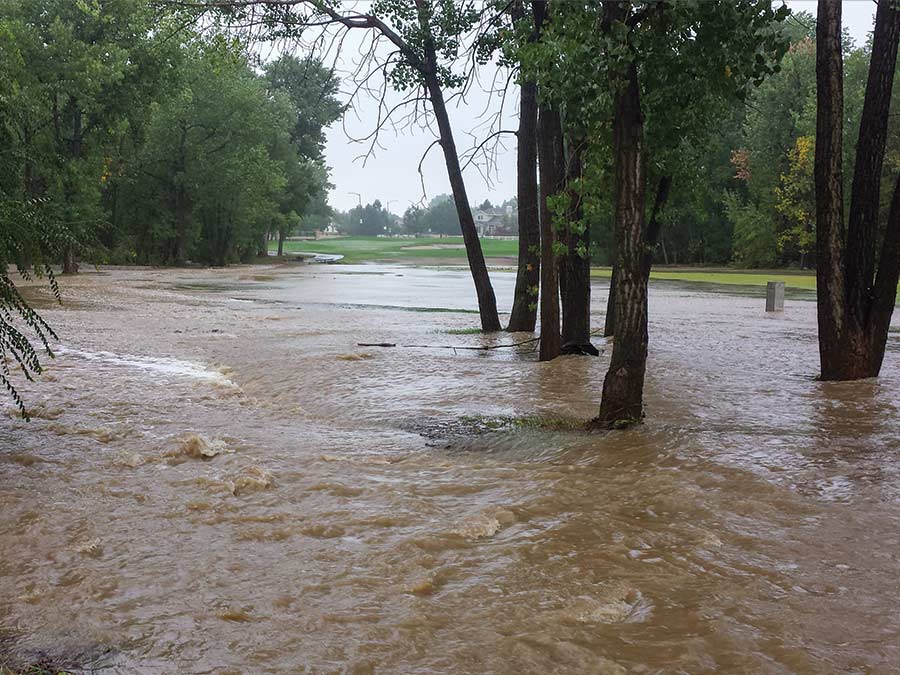Drive Away Hunger Golf Classic 2025
Join Community Table on August 25 at Fossil Trace Golf Club

By Chris Wheeler
Photographs by Wheeler Golfscapes
BY 2013, Coal Creek Golf Course sorely needed a face-lift. After 23 years of steady play and invasive trees and vegetation, Louisville’s Dick Phelps-designed layout was showing its age. The course staff and city officials had already initiated a comprehensive management plan identifying the issues, but as storm clouds gathered in the late summer, the team got a not-so-subtle shove from Mother Nature.

On September 13, 2013, torrential rains in the mountains west of Boulder turned the normally placid Coal Creek into a raging torrent of water that surged over its banks on the course’s west side. “This wasn’t the 100- year flood,” City of Louisville Parks Planner Allan Gill remembers. “It was a 400- or 500- year event.”
The floodwaters backed up at the south side of Dillon Road, a four-lane street that bisects Coal Creek Golf Course. Logs, rocks, garbage and other upriver debris clogged three golfer/pedestrian underpasses. Within minutes, the pressure of the water was too much. Like the breeching of a dam, the floodwaters shot through from the underpasses, unleashing chaos onto the north side of the course. “The water moved fast enough to push rocks and boulders around,” describes golf course architect Kevin Norby, who surveyed the destruction. “Trees were uprooted. Cart paths swept away.”
Silt, sediment and trash from the flooded Coal Creek poisoned fairways, greens and ponds. Four to six inches of precious topsoil washed downstream. Large chunks of splintered concrete from cart paths littered the course. The worst damage was to the very heart of golf course operations. “Pump stations were damaged,” Coal Creek’s Head PGA Professional David Baril recalls. “Irrigation lines were broken. Communication lines with the irrigation system were destroyed.” It appeared to be a lethal blow to the city-owned golf course. “At the time, we didn’t know if we could rebuild it,” Gill says. “We thought we might lose it.”
Within the storm clouds of catastrophe came a silver lining. “This was a chance for a reboot,” said Baril, a thirty-year veteran of the golf industry. “We could take an older design and update it.” The floodgates of Coal Creek opened doors of opportunity. The City of Louisville tapped into their “rainy day” fund and committed over $3 million to bringing back their local links. Grants from FEMA began to flow into the course.

Within days, Landscapes Unlimited and course architect Kevin Norby of Norby Golf Design began the awesome task of bringing Coal Creek Golf Course back to life. In 2014, the devastated irrigation system was replaced with a new design that promoted more efficient use of water. Norby implemented ways to improve Coal Creek’s design. He widened fairways, repositioned and reconstructed bunkers, leveled tees and elegantly re- sculpted numerous holes. “We were doing major reconstructive surgery,” recalled David Baril.
Important to the new design was Norby’s plan to make Coal Creek a more prominent part of the course. Before the flood, overgrown trees and walls of brush blocked views of the creek as it meandered through the layout. “It is the namesake of the course, but before the flood, the creek no longer contributed to the natural beauty,” Norby says. “So, we began to open up the corridors to make the course more playable and once again reveal the beauty of Coal Creek.”
In the spring and summer of 2014, the fairways, greens and rough began to be seeded with T1 bentgrass on the greens and Kentucky bluegrass on the rest of the course. Working with Landscapes Unlimited and Norby Designs was newly hired Course Superintendent David Dean. “I’ve always wanted to do a new build or a reconstruction,” says Dean, who came aboard a year after the flood.
Remarkably, less than two years after floodwaters devastated it, the Louisville layout was slated to reopen in June 2015. But the course, which is built on a flood plain, would first undergo one final critical test. A storm on Mother’s Day once again brought Coal Creek from its banks. “The flood tested the redesign, especially the elevated greens and tee boxes,” Dean says. “It proved what they put together could handle a flood. Everything design-wise worked the way it was supposed to.”
Amid much joy and fanfare, Coal Creek reopened on schedule in June 2015. After two years of “reconstructive surgery,” Baril’s work was in many ways just beginning. Managing golfer expectations would be another phase of the rebuild. “People would ask, ‘Why isn’t the ball sitting up in the fairway like it used to? Why aren’t the greens faster?,’” Baril recalls. “We had to educate people that this is a brand-new golf course. It just takes time to become a mature golf course.”

Eight years after being devastated by flood, Coal Creek’s grow-in is now complete. “People are happy with the design, the greens, the turf health,” Dean reports. “The end result is a far superior product than what was here before,” Baril adds.
Yet when the clouds dump snow and rain onto the Continental Divide, the staff of Coal Creek cannot help but look upriver– and imagine the worst. “Creeks and rivers have one job: to flood,” says Baril. “It’s going to happen again. You just hope it is not as devastating.”
The rebirth of the beautiful course along Coal Creek is model of collaboration between architects, engineers, golf professionals and civic leaders. However, the story of Coal Creek Golf Course is a sobering reminder that in the ebb and flow between nature and man, nature holds the upper hand. Everyone at Coal Creek Golf Course is proud to be part of its renaissance. But no one wants to go through this kind of experience again.
This article was also featured in the July 2021 Issue of Colorado AvidGolfer.
Colorado AvidGolfer is the state’s leading resource for golf and the lifestyle that surrounds it, publishing eight issues annually and proudly delivering daily content via coloradoavidgolfer.com.
Join Community Table on August 25 at Fossil Trace Golf Club
Steamboat Springs is like a secret only you and your friends know
Vail Valley is home to an endless array of summer outdoor pursuits